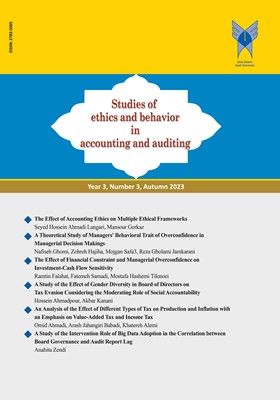تأثیر محدودیت مالی و بیشاعتمادی مدیران بر حساسیت سرمایهگذاری به جریان نقد
الموضوعات : مطالعات اخلاق و رفتار در حسابداری و حسابرسی
رامتین فلاحت
1
![]() ,
فاطمه صمدی
2
,
مصطفی تیله نوئی
3
,
فاطمه صمدی
2
,
مصطفی تیله نوئی
3
1 - دانشجوی کارشناسی ارشد، گروه مدیریت، واحد تهران شرق، دانشگاه آزاد اسلامی، تهران، ایران
2 - استادیار، گروه مدیریت، دانشکده علوم انسانی، واحد تهران شرق، دانشگاه آزاد اسلامی، تهران، ایران
3 - استادیار، گروه مدیریت، دانشکده علوم انسانی، واحد تهران شرق، دانشگاه آزاد اسلامی، تهران، ایران.
الکلمات المفتاحية: بیشاعتمادی مدیران, بیشسرمایهگذاری, جریان نقد, محدودیت مالی,
ملخص المقالة :
هدف: دسترسی به وجوه نقد برای شرکتها، در تحقق برنامههای سرمایهگذاری بسیار کلیدی است، اما ممکن است در شرایط مختلف، تاثیرپذیری سرمایهگذاری از جریان نقد تغییر کند. بر همین اساس، مطالعه حاضر به بررسی تاثیر محدودیت مالی و بیشاعتمادی مدیران بر حساسیت سرمایهگذاری به جریان نقد پرداخته است.روش: نمونه آماری مورد مطالعه شامل 153 شرکت پذیرفته شده در بورس اوراق بهادار تهران طی سالهای 1392 تا 1400 است و اطلاعات مورد نیاز از صورتهای مالی حسابرسی شده که در سایت کدال موجود است، گردآوری شدهاند. در این مطالعه هشت فرضیه تبیین شده است که با استفاده از تکنیکهای اقتصادسنجی رگرسیون اثرات ثابت و رگرسیون پروبیت، در نرمافزار ایویوز مورد آزمون قرار گرفتهاند.یافتهها: جریان نقد تاثیر مثبت و معناداری بر سرمایهگذاری و بیشسرمایهگذاری دارد. همچنین محدودیت مالی، حساسیت مثبت سرمایهگذاری و بیشسرمایهگذاری به جریان نقد را افزایش میدهد، ولی بیشاعتمادی مدیران تاثیری بر حساسیت سرمایهگذاری و بیشسرمایهگذاری به جریان نقد ندارد. با این وجود، زمانی که تعامل محدودیت مالی و بیشاعتمادی مدیران، در نظر گرفته میشود، حساسیت مثبت سرمایهگذاری و بیشسرمایهگذاری به جریان نقد، تقویت میشود که حاکی از نقش مهم محدودیت مالی در اتخاذ تصمیمات سرمایهگذاری است.نتیجهگیری: یافتههای این مطالعه با حمایت از تئوری حساسیت سرمایهگذاری به جریان نقد، نشان میدهد که محدودیت مالی، بیشاعتمادی مدیران و جریانهای نقد، همگی نقشی حیاتی در تصمیمگیریهای سرمایهگذاری شرکت ایفا میکنند.
Arslan, O., Florackis, C. & Ozkan, A. (2006). The role of cash holdings in reducing investment cash flow sensitivity: Evidence from a financial crisis period in an emerging market. Emerging Markets Review, 7(4), p.320–338.
Arslan-Ayaydin, O., Florackis, C. & Ozkan, A. (2014). Financial flexibility, corporate investment and performance: Evidence from financial crises. Review of Quantitative Finance and Accounting, 42(2), p.211–250.
Ascioglu, A., Hegde, S.P. & McDermott, J.B. (2008). Information asymmetry and investment–cash flow sensitivity. Journal of Banking & Finance, 32(6), p.1036–1048.
Ben-David, I., Graham, J.R. & Harvey, C.R. (2007). Managerial overconfidence and corporate policies. National Bureau of Economic Research.
Bhuiyan, M.B.U. & Hooks, J. (2019). Cash holding and over-investment behavior in firms with problem directors. International Review of Economics & Finance, 61, p.35–51.
Campbell, T., Gallmeyer, M., Johnson, S., Rutherford, J. & Stanley, B. (2011). CEO optimism and forced turnover. Journal of Financial Economics, 101(3), p.695–712.
Chiu, C.J., Ho, A. Y-F. & Tsai, L-F. (2022). Effects of financial constraints and managerial overconfidence on investment-cash flow sensitivity. International Review of Economics and Finance, 82(2022), p.135–155.
Choi, P.M.S., Chung, C.Y. & Liu, C. (2018). Self-attribution of overconfident CEOs and asymmetric investment-cash flow sensitivity. The North American Journal of Economics and Finance, 46, p.1–14.
Deshmukh, S., Goel, A. & Howe, K. (2013). CEO overconfidence and dividend policy. Journal of Financial Intermediation, 22(3), p.440–463.
Fazzari, S., Hubbard, R., Petersen, B., Blinder, A. & Poterba, J. (1988). Financing constraints and corporate investment. Brookings Papers on Economic Activity, No.141.
Goel, A.M. & Thakor, A.V. (2008). Overconfidence, CEO selection, and corporate governance. The Journal of Finance, 63(6), p.2737–2784.
Gul, S. & Tastan, H. (2020). The impact of monetary policy stance, financial conditions, and the
GFC on investment-cash flow sensitivity. International Review of Economics & Finance, 69,
p.692–707.
He, Y., Chen, C. & Hu, Y. (2019). Managerial overconfidence, internal financing, and investment efficiency: Evidence from China. Research in International Business and Finance, 47, p.501–510.
Heaton, J. (2002). Managerial optimism and corporate finance. Financial Management, 31(2),
p.33–45.
Hoshi, T., Kashyap, A. & Scharfstein, D. (1991). Corporate structure, liquidity, and investment: Evidence from Japanese industrial groups. Quarterly Journal of Economics,106(1), p.33–60.
Huang-Meier, W., Lambertides, N. & Steeley, J.M. (2016). Motives for corporate cash holdings: The CEO optimism effect. Review of Quantitative Finance and Accounting, 47(3), p.699–732.
Jensen, M.C. (1986). Agency cost of free cash flow, corporate finance, and takeovers. The American Economic Review, 76(2), p.323–329.
Lewellen, J. & Lewellen, K. (2016). Investment and cash flow: New evidence. Journal of Financial and Quantitative Analysis,51(4), p.1135–1164.
Lin, Y.H., Hu, S.Y. & Chen, M.S. (2005). Managerial optimism and corporate investment: Some empirical evidence from Taiwan. Pacific-Basin Finance Journal,13(5), p.523–546.
Malmendier, U. & Tate, G. (2005). CEO overconfidence and corporate investment. The Journal of Finance, 60(6), p.2661–2700.
Malmendier, U., Tate, G. & Yan, J. (2011). Overconfidence and early-life experiences: The effect of managerial traits on corporate financial policies. The Journal of Finance, 66(5), p.1687–1733.
Mohamed, E.B. & Shehata, M.A. (2017). R&D investment–cash flow sensitivity under managerial optimism. Journal of Behavioral and Experimental Finance, 14, p.1–4.
Mulier, K., Schoors, K. & Merlevede, B. (2016). Investment-cash flow sensitivity and financial constraints: Evidence from unquoted European SMEs. Journal of Banking & Finance, 73,
p.182–197.
Myers, S.C. & Majluf, N.S. (1984). Corporate financing and investment decisions when firms have information that investors do not have (No. w1396). National Bureau of Economic Research.
Richardson, S. (2006). Over-investment of free cash flow. Review of Accounting Studies, 11(2-3), p.159–189.
Yung, K., Li, D.D. & Jian, Y. (2015). The value of corporate financial flexibility in emerging countries. Journal of Multinational Financial Management, 32, p.25–41.
_||_


